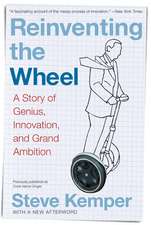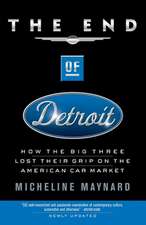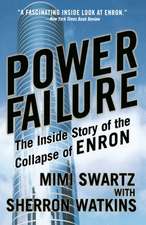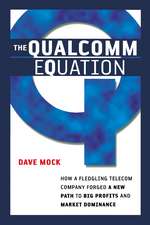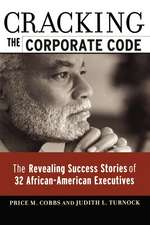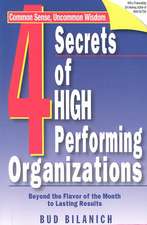Wal-Mart: How the High Cost of Everyday Low Prices Is Hurting America
Autor Anthony Biancoen Limba Engleză Paperback – 31 ian 2007
The Bully of Bentonville exposes the zealous, secretive, small-town mentality that rules Wal-Mart and chronicles its far-reaching consequences. In a gripping, richly textured narrative, Anthony Bianco shows how Wal-Mart has driven down retail wages throughout the country, how their substandard pay and meager health-care policy and anti-union mentality have led to a large scales exploitation of workers, why their aggressive expansion inevitably puts locally owned stores out of business, and how their pricing policies have forced suppliers to outsource work and move thousands of jobs overseas.
Based on interviews with Wal-Mart employees, managers, executives, competitors, suppliers, customers, and community leaders, The Bully of Bentonville brings the truths about Wal-Mart into sharp focus.
Preț: 108.50 lei
Nou
Puncte Express: 163
Preț estimativ în valută:
20.76€ • 21.73$ • 17.18£
20.76€ • 21.73$ • 17.18£
Carte disponibilă
Livrare economică 15-29 martie
Preluare comenzi: 021 569.72.76
Specificații
ISBN-13: 9780385513579
ISBN-10: 0385513577
Pagini: 337
Dimensiuni: 141 x 208 x 20 mm
Greutate: 0.27 kg
Editura: Broadway Business
ISBN-10: 0385513577
Pagini: 337
Dimensiuni: 141 x 208 x 20 mm
Greutate: 0.27 kg
Editura: Broadway Business
Notă biografică
ANTHONY BIANCO has been a senior writer at BusinessWeek for twenty years and is the coauthor of the magazine's acclaimed cover story on Wal-Mart. He lives in New York City.
Extras
CHAPTER ONE
THE CASE AGAINST WAL-MART
H. Lee Scott Jr. looks every inch the chief executive of America’s biggest and most powerful corporation as he strides through the lobby of the Omni Los Angeles Hotel on his way to make the most important speech of his career. Wearing an expensive, well-tailored suit on his stocky frame, his hair carefully coiffed, and his corporate game face on, Scott shows no sign of his natural fear of public speaking. To the contrary, the fifty-four-year-old executive appears eager for the chance to justify his company, Wal-Mart Stores, to the 500 business and community leaders who await him in the Omni’s ballroom.
The Omni–a luxury high-rise located in a solidly pro-union, politically liberal city–is an unlikely venue for the chief executive of an Arkansas-based corporation that is famously frugal, deeply conservative, and Southern-fried to the core. Wal-Mart already has 180 stores in California, but its ambitious expansion plans call for it to quadruple this total while moving from the outskirts into the heart of Los Angeles and the state’s other big cities. In many Golden State locales, Wal-Mart was being denied the zoning and other clearances it needed, and so Scott has flown out on this February day in 2005 to make the case for himself and his company in person at a luncheon sponsored by Town Hall Los Angeles, a nonpartisan group that immodestly but not inaccurately bills itself as a forum “for the most important thinkers and leaders on Earth.”(1)
Scott takes the stage to polite applause and opens with an aw-shucks flourish reminiscent of the late Sam Walton, the disarmingly folksy “Mr. Sam,” who founded Wal-Mart in the remote Ozarks hill town of Bentonville in 1962. “I know that Town Hall Los Angeles has a national reputation for hosting conversations on the issues that matter–talks that feature prominent figures from the worlds of government, business, the nonprofit sector, and the arts,” Scott says. “It’s a little humbling for a shopkeeper from Arkansas to follow such folks to Town Hall’s distinguished podium.”(2)
Scott soon discards the faux humility to offer a ringing defense of the embattled company where he has worked for twenty-six years. By selling vast quantities of goods at its trademark “Every Day Low Prices,” Wal-Mart has single-handedly raised America’s standard of living, saving consumers about $100 billion a year, he contends. “These savings are a lifeline for millions of middle- and lower-income families who live from payday to payday,” he says. “In effect, it gives them a raise every time they shop with us.” As Scott tells it, Wal-Mart also provides good jobs for hundreds of thousands of equally deserving employees, offers even part-time workers generous health insurance and other benefits, and contributes hefty tax payments to thousands of towns and cities from sea to shining sea. “I believe that if you look at the facts with an open mind,” he says, “you’ll agree that Wal-Mart is good for America.”(3)
Scott accuses greedy labor unions, inefficient supermarket chains, and other Wal-Mart opponents of distorting “the facts” to suit their own purposes, undermining not only the company but also the nation. In so many words, the CEO contends that Wal-Mart is America and that to oppose the company’s advance into California and other growth markets is to oppose progress itself. “When someone builds a better mousetrap, it’s not the American way to deny average folks the chance to use it to improve their lives,” he says. “The horse and buggy industry wasn’t permitted to crush the car. The candle lobby wasn’t allowed to stop electric lights.” To deny Americans “the higher living standards that Wal-Mart’s business efficiency can bring is to make a mockery of American ideals under the guise of pursuing them.”(4)
Hold it right there. When America’s largest corporation conflates its self-interest with life, liberty, and the pursuit of happiness, alarm bells should go off in every city hall, statehouse, and union hall in the land. The outcry against Wal-Mart is rooted in the arrogance of its presumption that selling vast quantities of cut-rate merchandise entitles it to behave as if it represents the best interests of the American people. Scott likes to call Wal-Mart an “agent” of the consumer, but this seems far too mild a description of a company of such size, power, and righteous zeal. Its critics would argue that intimidator, enforcer, coercer, tyrant are more apt. In the name of the shopper, Wal-Mart systematically bullies its workers, its suppliers, and the residents of towns and cities disinclined to submit to the expansion imperative of a company currently opening new stores at the rate of 1.45 a day.
Who among us does not crave a bargain? But we Americans–including the financially strapped folks Wal-Mart claims as its own–are not defined by how much money we save down at the Supercenter. We are a nation of workers first and shoppers second; as the saying goes, “You got to work to eat.” We also are a nation of citizens entitled to vote as we choose, even if it means going against our financial self-interest as defined by Wal-Mart.
Today, Wal-Mart is besieged by critics on all sides, but perhaps the greatest threat it faces is from within–from unhappy, demoralized employees who are quitting at the rate of hundreds of thousands a year and who have dozens of class-action lawsuits pending against the company. On the very day that Scott was extolling Wal-Mart’s virtues at the Omni, a ragtag group of his low-level employees gathered 850 miles to the east to bite the hand that barely feeds them. Joined by dozens of supporters, they stationed themselves across the street from a Wal-Mart Supercenter in Loveland, Colorado–a fast-growing exurb of Denver–to loudly cheer on a drive to unionize the store’s tire-and-lube shop. Joshua Noble, the twenty-one-year-old leader of the rebellion against his virulently anti-union employer, is an epileptic who had to move back in with his parents because he could not afford to live on his Wal-Mart paycheck. “Always the low price means always paying your workers less,” Noble declares.(5)
The average Wal-Mart hourly employee makes substantially less than the $12.28 average for retail workers in the United States; although the exact amount is debatable, the highest figure, Wal-Mart’s own, is a mere $9.68 an hour. And starting wages are several dollars an hour less. Scott–who received $12,593,493 in salary, bonus, stock awards, and other compensation in 2004–defends Wal-Mart’s pay scale by rounding off the hourly average to $10 and noting that it is almost twice the federal minimum wage of $5.15. Even so, the typical employee working full-time at Wal-Mart makes just $17,600 a year, well below the $19,157 poverty line for a family of four.
Because Wal-Mart is so big, it has dragged down wages throughout the country. Economists at the University of California at Berkeley found that Wal-Mart’s expansion during the 1990s cut the income of America’s retail employees by 1.3 percent–or by $4.7 billion in 2000 alone.6 What is more, the depressing effect of Wal-Mart’s expansion on payrolls extends well beyond retailing. According to a 2005 analysis by economists at the Public Policy Institute of California, take-home pay per person fell by 5 percent across the board following Wal-Mart’s entry into a county. The evidence “strongly suggest(s) that Wal-Mart stores lead to wage declines, shifts to lower-paying jobs (or less skilled workers), or increased use of part-time workers,” the authors concluded, adding that the company’s impact on local labor markets was particularly pronounced in the South, where its stores are most numerous and where they have been open the longest.(7)
And the health insurance that Scott touted in his speech? Only 44 percent of Wal-Mart’s 1.3 million U.S. workers have signed up for even the least-expensive medical benefits that the company offers.(8) Many simply cannot afford even the minimum $1,000 deductible and the $35 monthly premium for individual and $141 for family coverage. The result? To make ends meet, many employees see no alternative to going on the dole. An astounding 46 percent of the children of Wal-Mart workers are uninsured or on Medicaid.(9) “For being such a big company, Wal-Mart has a very poor benefits plan,” complains Noble, who pays nearly $200 a month for his health insurance plus another $100 for the prescription medicine that prevents his epileptic seizures.(10)
Unhappy Wal-Mart workers complain as much about being overworked as underpaid. The company deliberately understaffs its stores to hold down payroll costs on one hand, and yet is absolutely allergic to paying hourly workers overtime on the other, putting its store managers in the position of finding ways to reconcile the irreconcilable or suffer the career consequences. The obvious, though generally illegal, solution is to force employees to work extra hours without pay, either by eliminating meal and rest breaks or by having them punch out and keep working “off the clock.” To a certain unquantifiable extent, Wal-Mart’s labor cost advantage is the product of playing fast and loose with its own stated policies at its employees’ expense.
In 2000, Wal-Mart did its own audit of one week’s time-clock records for 128 stores employing 25,000 hourly workers in total. What they found was shocking–three apparent violations for each worker: 60,767 instances of rest breaks not taken, 15,705 instances of meal breaks forgone, and 1,371 instances of minor-age employees working excessive hours or at inappropriate times (during school hours, for example). Despite this, the company took no corrective action whatsoever, and instead disavowed its own audit after it was leaked to the New York Times in 2004, claiming that it had no way of knowing whether workers hadn’t simply forgotten to sign out as they came and went. “Our view,” said a spokesman, “is that the audit really means nothing.”(11) Others do not agree–federal and state authorities have repeatedly cited and fined Wal-Mart for labor-law violations, including hiring outside contractors who employ illegal aliens.
Wal-Mart insists on describing itself as “pro-associate, not anti-union,” but it is ruthless in trying to suppress any and all attempts by unions to organize its stores. One of the company’s standard-issue manuals for store-level supervisors is the Managers’ Toolbox to Remaining Union-Free, which urges managers to keep an eye open for such telltale signs of incipient unionism as “frequent meetings at associates’ homes” or “associates who are never seen together . . . talking or associating with each other.” By some accounts, Wal-Mart headquarters conducts covert surveillance of employee telephone calls and e-mails. Whenever it does detect pro-union sentiment at a store, the home office dispatches a “labor relations team” by private jet to cajole and intimidate dissident workers into toeing its strict anti-union line.
In a rare instance of defiance, workers in a store in Jonquière, Québec–North America’s staunchest bastion of trade unionism–voted in the fall of 2004 to join the union that Wal-Mart considers its archenemy, the United Food and Commercial Workers. In apparent retaliation, Wal-Mart, to the outrage of the people of Québec, shut down the store, which still had sixteen years to run on its twenty-year lease, and put 190 workers on the street in an area with one of Canada’s highest unemployment rates.
Without a union to protect them, aggrieved Wal-Mart employees are turning to the courts. In 2005, the company faced more than forty class-action suits in thirty states alleging that it forces employees to work extra hours without pay, including a case in Texas brought on behalf of 200,000 workers who claim that Wal-Mart owes them $150 million for forcing them to work through their fifteen-minute breaks over a four-year period. In Massachusetts, lawyers representing 55,000 workers claim to have documented 7,000 different instances of managers deleting large blocks of time from payroll records. Wal-Mart settled one such case in Colorado in 2001 by distributing $50 million in unpaid wages to 69,000 employees. A year later, an Oregon jury delivered a guilty verdict against the company in the first of these so-called wage-and-hour cases to go to trial.
Scores of other lawsuits allege that Wal-Mart routinely violated laws against discrimination in denying women, black, and Hispanic workers raises and promotions. A sex-discrimination case certified in mid-2004 by a federal judge in California is the largest civil rights class-action suit in history by several orders of magnitude. The case, Dukes v. Wal-Mart, encompasses the claims of every woman who has worked at Wal-Mart since late 1998–1.6 million workers all told.
In its attempts to prevent the case from broadening beyond the six original plaintiffs, Wal-Mart claimed that each store was “different” from the others and that at worst there were only a few “bad apples” among its store managers. Its own records tell a different story: Since 1997, female employees were paid 5 percent to 15 percent less than men working the same jobs in every part of the country, despite having higher performance ratings and more seniority on average. Women comprise two-thirds of all hourly workers but received only one-third of all promotions to management positions. At Wal-Mart, a mere 33 percent of managers are women, compared with 56 percent at the company’s top twenty competitors, according to a study commissioned by the plaintiffs. The depositions of hundreds of female employees filed in support of the case are liberally spiced with tales of good ol’ boys behaving badly: the home-office exec who routinely told mixed-gender groups of employees they should strive to make customers feel as if they could trust them “with their wife and their wallet”; the Midwestern district manager who liked to hold business meetings at Hooters; the “Spirit Committee” of a Wisconsin store that brought in a stripper to perform at a staff session in celebration of the manager’s birthday.
Wal-Mart workers are quitting in far greater numbers than they are filing lawsuits or signing union representation cards. Turnover among hourly employees is nearly 50 percent a year, about double the rate of Costco, which long ago supplanted its much larger rival as America’s big-box employer of choice. To replace the workers who are voting with their feet and leaving, Wal-Mart must hire about 600,000 new employees a year in the United States alone–a figure without precedent in the annals of business. In addition, the company filled 125,000 new positions in 2005–a figure that will only grow as it continues to add 280 to 300 new stores a year.
Viewed from the Olympian heights of Bentonville, high turnover in Wal-Mart’s stores is not all bad. The constant churn sharply reduces the number of employees eligible for raises and promotions–holding the average wage down–and also assures that the great majority of workers do not stick around long enough to have the chance to vote in a union election or file a discrimination suit. Still, an awful lot of warm bodies are needed to keep the Wal-Mart sales machine humming. How long can the company sustain its manic hiring pace before it cycles through the entire blue-collar population of America? And at what cost? Hiring and training a replacement worker costs Wal-Mart $2,500 on average, or about $2 billion a year.
From the Hardcover edition.
THE CASE AGAINST WAL-MART
H. Lee Scott Jr. looks every inch the chief executive of America’s biggest and most powerful corporation as he strides through the lobby of the Omni Los Angeles Hotel on his way to make the most important speech of his career. Wearing an expensive, well-tailored suit on his stocky frame, his hair carefully coiffed, and his corporate game face on, Scott shows no sign of his natural fear of public speaking. To the contrary, the fifty-four-year-old executive appears eager for the chance to justify his company, Wal-Mart Stores, to the 500 business and community leaders who await him in the Omni’s ballroom.
The Omni–a luxury high-rise located in a solidly pro-union, politically liberal city–is an unlikely venue for the chief executive of an Arkansas-based corporation that is famously frugal, deeply conservative, and Southern-fried to the core. Wal-Mart already has 180 stores in California, but its ambitious expansion plans call for it to quadruple this total while moving from the outskirts into the heart of Los Angeles and the state’s other big cities. In many Golden State locales, Wal-Mart was being denied the zoning and other clearances it needed, and so Scott has flown out on this February day in 2005 to make the case for himself and his company in person at a luncheon sponsored by Town Hall Los Angeles, a nonpartisan group that immodestly but not inaccurately bills itself as a forum “for the most important thinkers and leaders on Earth.”(1)
Scott takes the stage to polite applause and opens with an aw-shucks flourish reminiscent of the late Sam Walton, the disarmingly folksy “Mr. Sam,” who founded Wal-Mart in the remote Ozarks hill town of Bentonville in 1962. “I know that Town Hall Los Angeles has a national reputation for hosting conversations on the issues that matter–talks that feature prominent figures from the worlds of government, business, the nonprofit sector, and the arts,” Scott says. “It’s a little humbling for a shopkeeper from Arkansas to follow such folks to Town Hall’s distinguished podium.”(2)
Scott soon discards the faux humility to offer a ringing defense of the embattled company where he has worked for twenty-six years. By selling vast quantities of goods at its trademark “Every Day Low Prices,” Wal-Mart has single-handedly raised America’s standard of living, saving consumers about $100 billion a year, he contends. “These savings are a lifeline for millions of middle- and lower-income families who live from payday to payday,” he says. “In effect, it gives them a raise every time they shop with us.” As Scott tells it, Wal-Mart also provides good jobs for hundreds of thousands of equally deserving employees, offers even part-time workers generous health insurance and other benefits, and contributes hefty tax payments to thousands of towns and cities from sea to shining sea. “I believe that if you look at the facts with an open mind,” he says, “you’ll agree that Wal-Mart is good for America.”(3)
Scott accuses greedy labor unions, inefficient supermarket chains, and other Wal-Mart opponents of distorting “the facts” to suit their own purposes, undermining not only the company but also the nation. In so many words, the CEO contends that Wal-Mart is America and that to oppose the company’s advance into California and other growth markets is to oppose progress itself. “When someone builds a better mousetrap, it’s not the American way to deny average folks the chance to use it to improve their lives,” he says. “The horse and buggy industry wasn’t permitted to crush the car. The candle lobby wasn’t allowed to stop electric lights.” To deny Americans “the higher living standards that Wal-Mart’s business efficiency can bring is to make a mockery of American ideals under the guise of pursuing them.”(4)
Hold it right there. When America’s largest corporation conflates its self-interest with life, liberty, and the pursuit of happiness, alarm bells should go off in every city hall, statehouse, and union hall in the land. The outcry against Wal-Mart is rooted in the arrogance of its presumption that selling vast quantities of cut-rate merchandise entitles it to behave as if it represents the best interests of the American people. Scott likes to call Wal-Mart an “agent” of the consumer, but this seems far too mild a description of a company of such size, power, and righteous zeal. Its critics would argue that intimidator, enforcer, coercer, tyrant are more apt. In the name of the shopper, Wal-Mart systematically bullies its workers, its suppliers, and the residents of towns and cities disinclined to submit to the expansion imperative of a company currently opening new stores at the rate of 1.45 a day.
Who among us does not crave a bargain? But we Americans–including the financially strapped folks Wal-Mart claims as its own–are not defined by how much money we save down at the Supercenter. We are a nation of workers first and shoppers second; as the saying goes, “You got to work to eat.” We also are a nation of citizens entitled to vote as we choose, even if it means going against our financial self-interest as defined by Wal-Mart.
Today, Wal-Mart is besieged by critics on all sides, but perhaps the greatest threat it faces is from within–from unhappy, demoralized employees who are quitting at the rate of hundreds of thousands a year and who have dozens of class-action lawsuits pending against the company. On the very day that Scott was extolling Wal-Mart’s virtues at the Omni, a ragtag group of his low-level employees gathered 850 miles to the east to bite the hand that barely feeds them. Joined by dozens of supporters, they stationed themselves across the street from a Wal-Mart Supercenter in Loveland, Colorado–a fast-growing exurb of Denver–to loudly cheer on a drive to unionize the store’s tire-and-lube shop. Joshua Noble, the twenty-one-year-old leader of the rebellion against his virulently anti-union employer, is an epileptic who had to move back in with his parents because he could not afford to live on his Wal-Mart paycheck. “Always the low price means always paying your workers less,” Noble declares.(5)
The average Wal-Mart hourly employee makes substantially less than the $12.28 average for retail workers in the United States; although the exact amount is debatable, the highest figure, Wal-Mart’s own, is a mere $9.68 an hour. And starting wages are several dollars an hour less. Scott–who received $12,593,493 in salary, bonus, stock awards, and other compensation in 2004–defends Wal-Mart’s pay scale by rounding off the hourly average to $10 and noting that it is almost twice the federal minimum wage of $5.15. Even so, the typical employee working full-time at Wal-Mart makes just $17,600 a year, well below the $19,157 poverty line for a family of four.
Because Wal-Mart is so big, it has dragged down wages throughout the country. Economists at the University of California at Berkeley found that Wal-Mart’s expansion during the 1990s cut the income of America’s retail employees by 1.3 percent–or by $4.7 billion in 2000 alone.6 What is more, the depressing effect of Wal-Mart’s expansion on payrolls extends well beyond retailing. According to a 2005 analysis by economists at the Public Policy Institute of California, take-home pay per person fell by 5 percent across the board following Wal-Mart’s entry into a county. The evidence “strongly suggest(s) that Wal-Mart stores lead to wage declines, shifts to lower-paying jobs (or less skilled workers), or increased use of part-time workers,” the authors concluded, adding that the company’s impact on local labor markets was particularly pronounced in the South, where its stores are most numerous and where they have been open the longest.(7)
And the health insurance that Scott touted in his speech? Only 44 percent of Wal-Mart’s 1.3 million U.S. workers have signed up for even the least-expensive medical benefits that the company offers.(8) Many simply cannot afford even the minimum $1,000 deductible and the $35 monthly premium for individual and $141 for family coverage. The result? To make ends meet, many employees see no alternative to going on the dole. An astounding 46 percent of the children of Wal-Mart workers are uninsured or on Medicaid.(9) “For being such a big company, Wal-Mart has a very poor benefits plan,” complains Noble, who pays nearly $200 a month for his health insurance plus another $100 for the prescription medicine that prevents his epileptic seizures.(10)
Unhappy Wal-Mart workers complain as much about being overworked as underpaid. The company deliberately understaffs its stores to hold down payroll costs on one hand, and yet is absolutely allergic to paying hourly workers overtime on the other, putting its store managers in the position of finding ways to reconcile the irreconcilable or suffer the career consequences. The obvious, though generally illegal, solution is to force employees to work extra hours without pay, either by eliminating meal and rest breaks or by having them punch out and keep working “off the clock.” To a certain unquantifiable extent, Wal-Mart’s labor cost advantage is the product of playing fast and loose with its own stated policies at its employees’ expense.
In 2000, Wal-Mart did its own audit of one week’s time-clock records for 128 stores employing 25,000 hourly workers in total. What they found was shocking–three apparent violations for each worker: 60,767 instances of rest breaks not taken, 15,705 instances of meal breaks forgone, and 1,371 instances of minor-age employees working excessive hours or at inappropriate times (during school hours, for example). Despite this, the company took no corrective action whatsoever, and instead disavowed its own audit after it was leaked to the New York Times in 2004, claiming that it had no way of knowing whether workers hadn’t simply forgotten to sign out as they came and went. “Our view,” said a spokesman, “is that the audit really means nothing.”(11) Others do not agree–federal and state authorities have repeatedly cited and fined Wal-Mart for labor-law violations, including hiring outside contractors who employ illegal aliens.
Wal-Mart insists on describing itself as “pro-associate, not anti-union,” but it is ruthless in trying to suppress any and all attempts by unions to organize its stores. One of the company’s standard-issue manuals for store-level supervisors is the Managers’ Toolbox to Remaining Union-Free, which urges managers to keep an eye open for such telltale signs of incipient unionism as “frequent meetings at associates’ homes” or “associates who are never seen together . . . talking or associating with each other.” By some accounts, Wal-Mart headquarters conducts covert surveillance of employee telephone calls and e-mails. Whenever it does detect pro-union sentiment at a store, the home office dispatches a “labor relations team” by private jet to cajole and intimidate dissident workers into toeing its strict anti-union line.
In a rare instance of defiance, workers in a store in Jonquière, Québec–North America’s staunchest bastion of trade unionism–voted in the fall of 2004 to join the union that Wal-Mart considers its archenemy, the United Food and Commercial Workers. In apparent retaliation, Wal-Mart, to the outrage of the people of Québec, shut down the store, which still had sixteen years to run on its twenty-year lease, and put 190 workers on the street in an area with one of Canada’s highest unemployment rates.
Without a union to protect them, aggrieved Wal-Mart employees are turning to the courts. In 2005, the company faced more than forty class-action suits in thirty states alleging that it forces employees to work extra hours without pay, including a case in Texas brought on behalf of 200,000 workers who claim that Wal-Mart owes them $150 million for forcing them to work through their fifteen-minute breaks over a four-year period. In Massachusetts, lawyers representing 55,000 workers claim to have documented 7,000 different instances of managers deleting large blocks of time from payroll records. Wal-Mart settled one such case in Colorado in 2001 by distributing $50 million in unpaid wages to 69,000 employees. A year later, an Oregon jury delivered a guilty verdict against the company in the first of these so-called wage-and-hour cases to go to trial.
Scores of other lawsuits allege that Wal-Mart routinely violated laws against discrimination in denying women, black, and Hispanic workers raises and promotions. A sex-discrimination case certified in mid-2004 by a federal judge in California is the largest civil rights class-action suit in history by several orders of magnitude. The case, Dukes v. Wal-Mart, encompasses the claims of every woman who has worked at Wal-Mart since late 1998–1.6 million workers all told.
In its attempts to prevent the case from broadening beyond the six original plaintiffs, Wal-Mart claimed that each store was “different” from the others and that at worst there were only a few “bad apples” among its store managers. Its own records tell a different story: Since 1997, female employees were paid 5 percent to 15 percent less than men working the same jobs in every part of the country, despite having higher performance ratings and more seniority on average. Women comprise two-thirds of all hourly workers but received only one-third of all promotions to management positions. At Wal-Mart, a mere 33 percent of managers are women, compared with 56 percent at the company’s top twenty competitors, according to a study commissioned by the plaintiffs. The depositions of hundreds of female employees filed in support of the case are liberally spiced with tales of good ol’ boys behaving badly: the home-office exec who routinely told mixed-gender groups of employees they should strive to make customers feel as if they could trust them “with their wife and their wallet”; the Midwestern district manager who liked to hold business meetings at Hooters; the “Spirit Committee” of a Wisconsin store that brought in a stripper to perform at a staff session in celebration of the manager’s birthday.
Wal-Mart workers are quitting in far greater numbers than they are filing lawsuits or signing union representation cards. Turnover among hourly employees is nearly 50 percent a year, about double the rate of Costco, which long ago supplanted its much larger rival as America’s big-box employer of choice. To replace the workers who are voting with their feet and leaving, Wal-Mart must hire about 600,000 new employees a year in the United States alone–a figure without precedent in the annals of business. In addition, the company filled 125,000 new positions in 2005–a figure that will only grow as it continues to add 280 to 300 new stores a year.
Viewed from the Olympian heights of Bentonville, high turnover in Wal-Mart’s stores is not all bad. The constant churn sharply reduces the number of employees eligible for raises and promotions–holding the average wage down–and also assures that the great majority of workers do not stick around long enough to have the chance to vote in a union election or file a discrimination suit. Still, an awful lot of warm bodies are needed to keep the Wal-Mart sales machine humming. How long can the company sustain its manic hiring pace before it cycles through the entire blue-collar population of America? And at what cost? Hiring and training a replacement worker costs Wal-Mart $2,500 on average, or about $2 billion a year.
From the Hardcover edition.
Recenzii
“[The Bully of Bentonville]…is filled with direct quotations from current and former Wal-Mart employees, paraphrased anecdotes from Wal-Mart lore, Sam Walton legends, data from government documents and studies from academic researchers such as Basker. Not a single page…is boring, whether the reader is a Wal-Mart lover, Wal-Mart hater, or a conflicted in-between sometimes shopper.” —The Kansas City Star
“In The Bully of Bentonville Bianco produces the most penetrating examination of Wal-Mart’s business practices and their ripple effects in American society that has been published since Wal-Mart watching became a serious pursuit of the business press and academia.” — The Star Telegram
From the Hardcover edition.
“In The Bully of Bentonville Bianco produces the most penetrating examination of Wal-Mart’s business practices and their ripple effects in American society that has been published since Wal-Mart watching became a serious pursuit of the business press and academia.” — The Star Telegram
From the Hardcover edition.

